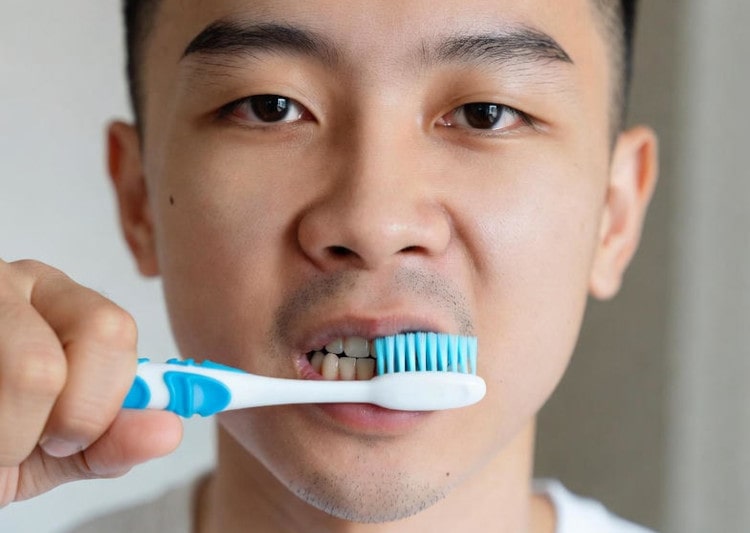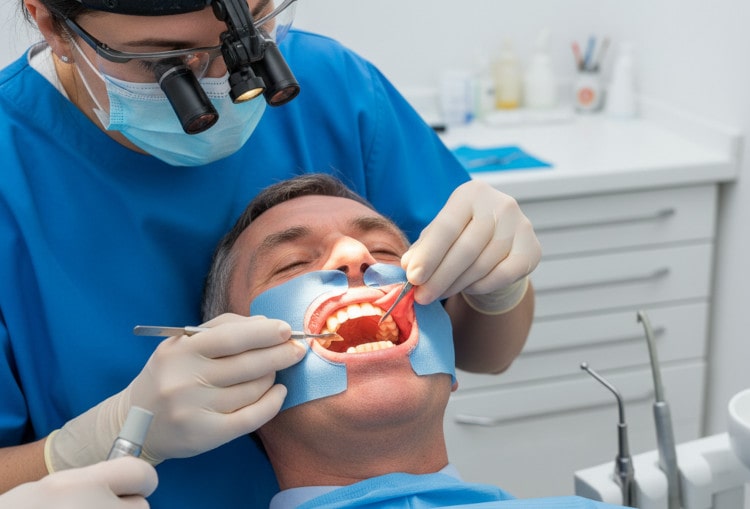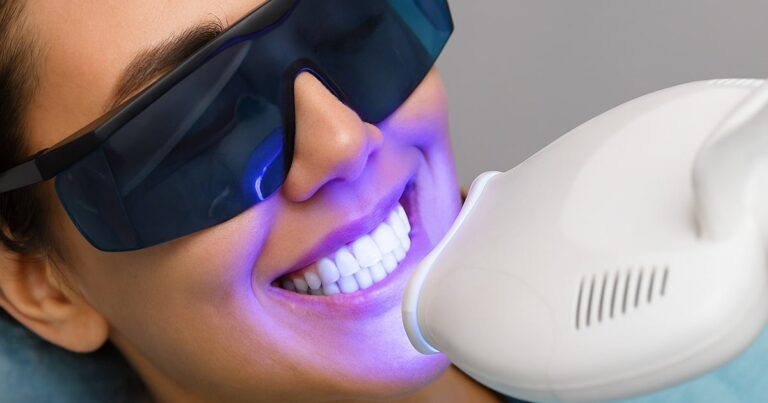You might be startled if you see blood in your sink while you are brushing your teeth, and it’s natural to wonder if you should panic. However, the reality is more complicated than a simple yes or no. Bleeding gums when brushing can range from a minor annoyance, which is caused by aggressive scrubbing, to an early warning sign of gum disease that needs a periodontist. This guide explores the causes, when to worry, and what steps you can take to address bleeding gums so you can brush effectively.
Understanding Bleeding Gums: The Basics

Bleeding gums when brushing are far more common than you might think. It affects a great number of the population. According to PubMed, about 46% of people in the United States aged 30 years or older show signs of gum disease, and bleeding gums is one of the primary indicators. Healthy gums should never bleed, whether during routine oral care or spontaneously. When you see blood on your toothbrush or in the sink, it’s an indication that your gums are inflamed or irritated.
Common Causes of Bleeding Gums When Brushing
Now that you have a basic understanding of bleeding gums when brushing, let’s explore some of the common reasons it can happen.
Plaque Buildup and Poor Oral Hygiene
When plaque builds up around your gum line, it triggers an inflammatory response. Your body’s immune system recognizes the bacterial threat and starts inflammation as a defense mechanism. This inflammation causes your gums to become red, puffy, and tender, so they are much more prone to bleeding.
Take Charge of Your Gum Health Today
If you’re experiencing bleeding gums when brushing, it’s important not to ignore the signs. At My Dentist Langley, we provide professional cleanings and personalised treatment to help protect and restore your gum health.
Incorrect Brushing Technique

If you brush aggressively and apply excessive pressure while moving the toothbrush back and forth vigorously, it can damage your gum tissue directly. When you brush too hard, you’re essentially abrading your gums, which can lead to gum recession (where your gums pull away from your teeth) and bleeding.
Vitamin Deficiencies

Vitamin deficiencies can also contribute to bleeding gums when brushing. Vitamin C plays a critical role in tissue repair and collagen synthesis, which are essential to maintain healthy and resilient gum tissue. Similarly, vitamin K is necessary for proper blood clotting; without enough vitamin K, your blood may not clot efficiently.
Have you ever wondered how often you should replace your toothbrush for optimal oral health? Check out How Often Replace Toothbrush for some signs and advice.
Gingivitis: The Early Stage of Gum Disease
Gingivitis is the mildest form of gum disease. It’s characterized by inflammation of the gums and is a common cause of gum bleeding when you brush. Unlike more advanced stages of gum disease, gingivitis doesn’t involve bone loss and is typically reversible with proper treatment and improved oral hygiene.
Hormonal Changes and Pregnancy
Hormonal fluctuations during pregnancy, menstruation, and menopause can significantly affect your gums and lead to a condition sometimes called “pregnancy gingivitis.” These hormonal changes impact your body’s inflammatory response and make your gums more vulnerable to irritation and bleeding.
Medications and Medical Conditions
Some medications, especially blood thinners like warfarin and aspirin, can make your gums more prone to bleeding because they interfere with blood clotting. If you’ve recently started a new medication and noticed gum bleeding when brushing for the first time, this could be the cause.
When Should You Be Worried? Red Flags to Watch

It’s important to know when you should be concerned and need to contact your family dentist to protect your long-term oral health.
- Persistent bleeding that continues for more than two weeks despite improved oral hygiene.
- Severely swollen or tender gums.
- Visible pus between your teeth and gums.
- Gums that are pulling away from your teeth.
- Loose or shifting teeth.
- Persistent bad breath or a metallic taste in your mouth.
- Unexplained bruising or bleeding from small cuts elsewhere on your body.
- Pain when chewing.
- Gums have changed color dramatically.
Note: If you’ve recently changed your brushing technique or started flossing after a long break, some temporary bleeding is normal and typically resolves within a few days to a week as your gums adapt.
Read more: “How to Find the Best Emergency Dentist Near You: A Quick Guide”
Prevention and Management Methods
Start establishing and maintaining excellent oral hygiene practices to prevent bleeding gums when brushing. Let’s explore the most effective methods to keep your gums healthy and stop bleeding gums before they start.
- Proper Brushing Technique: Position your toothbrush at a 45-degree angle. Use gentle, circular motions rather than aggressive back-and-forth scrubbing, and brush for at least two minutes.
- Using the Right Toothbrush: Dental professionals recommend soft-bristled toothbrushes, as they effectively remove plaque without damaging delicate gum tissue.
- Daily Flossing: Gently guide the floss between your teeth with a sawing motion, then curve it into a C-shape against one tooth, slide it under your gum line, and move it up and down several times.
- Antimicrobial Mouthwash: Rinse with the mouthwash (which contains chlorhexidine or cetylpyridinium) for about 30-60 seconds after brushing and flossing.
- Regular Professional Cleanings: Most people benefit from professional teeth cleanings at least twice yearly, though those with a history of gum disease may need more frequent visits.
- Dietary Considerations: Don’t forget about fruits, vegetables, whole grains, lean proteins, dairy products, vitamins, and minerals (particularly vitamin C, vitamin K, and calcium).
- Quitting Tobacco Products: Smokeless tobacco is equally damaging. The sooner you quit, the sooner your gums can begin to recover.
Do you want to learn more about how flossing can benefit your teeth? Visit Flossing Teeth Benefits to discover the advantages.
Professional Treatment Options

It’s helpful to have knowledge about various professional treatment options available, because it helps you make informed decisions about your oral health care. Here is a table that explains each treatment option.
| Treatment Option | Explanation |
| Scaling and root planing | A deep-cleaning procedure, the first line of professional treatment for bleeding gums when brushing |
| Antibiotics | Help control bacterial infections that are causing the bleeding |
| Laser therapy | Uses a specialized laser to remove diseased gum tissue and kill bacteria below the gum line |
| Surgical procedures | Mainly used for advanced periodontitis with significant bone loss and deep periodontal pockets |
If you want to apply for the CDCP plan, take a look at Apply for CDCP for eligibility requirements and a comprehensive guide.
Don’t Ignore the Bleeding or It Will Get Worse!
Bleeding gums when brushing is a common problem, but it’s far from something you should simply accept or ignore. Sometimes, minor bleeding can happen if you brush too aggressively, but persistent or unexplained bleeding typically signals an underlying issue. Are you experiencing excessive gum bleeding and need an emergency dentist? At My Dentist Langley, we provide fast, effective care for urgent dental issues in Langley. Book an appointment at Emergency Dentist Langley.
FAQ
Is it normal for gums to bleed a little when brushing?
No, healthy gums should never bleed, even with gentle brushing. While some people experience minor bleeding when they’re new to flossing or after switching to a new oral care routine, this should resolve within a few days as your gums adapt. Persistent bleeding is a sign that your gums need attention and shouldn’t be ignored.
Can bleeding gums when brushing heal on their own?
Minor bleeding from adjusting your oral care routine may resolve independently within a few days. However, if it’s caused by gingivitis or plaque buildup, it requires improved oral hygiene and sometimes professional treatment to resolve completely. Without intervention, gum disease usually progresses rather than improves.
How long should I wait before seeing a dentist if my gums are bleeding when I brush?
If bleeding persists for more than two weeks despite improved oral hygiene, or if you notice other concerning symptoms like swelling, pain, pus, or loose teeth, see your dentist promptly. For occasional minor bleeding, you can give your gums a week to improve with better care before scheduling an appointment.
Can bleeding gums when brushing indicate a serious health condition?
Bleeding gums most commonly indicate gingivitis or poor oral hygiene, but they can sometimes signal other health issues like diabetes, blood clotting disorders, or vitamin deficiencies. This is another reason why persistent bleeding needs professional evaluation.
Have you ever experienced bleeding gums when brushing? Share your experience or questions below. We’re here to help and would love to hear from you!




